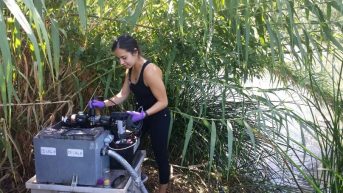Fish exposed to flowing river water to monitor for biological changes

SCCWRP and its partners exposed fish to flowing Los Angeles River water for two weeks in September as part of a pilot study examining potential biological impacts from exposure to chemical contaminants in the receiving water.
The fish were housed in mobile exposure chambers set up along the river bank in two locations – just downstream of the L.A.-Glendale Water Reclamation Plant, and in the Sepulveda Basin just upstream of the Tillman Water Reclamation Plant at a site that receives urban runoff.
This study marks the first time that mobile environmental monitoring units have been used to evaluate water quality in Southern California. Mobile exposure units offer the potential to replicate environmental conditions more accurately than exposing fish to water samples in a lab setting; the units control for factors such as flow rate, food source, illumination and dissolved oxygen.
SCCWRP and the City of Los Angeles Environmental Monitoring Division monitored the chambers daily for 14 days, removing some fish after six days and the remainder at the end of the 14th day.
The fish – all adult male fathead minnows – were dissected, and tissue samples were collected for analysis in the coming months. Meanwhile, river water collected during the exposure study also will be analyzed to identify CECs and priority pollutants.
CECs and priority pollutants, which can be found in both wastewater effluent and land-based runoff, have the potential to trigger biological effects in fish, including changes in gene expression, tissue integrity and sex characteristics.
The study design will be refined and repeated in spring 2018.
More news related to: Bioanalytical Cell Screening Assays, Emerging Contaminants